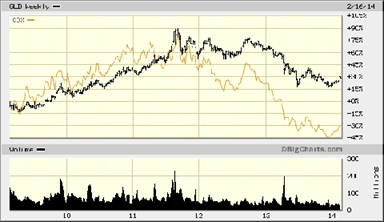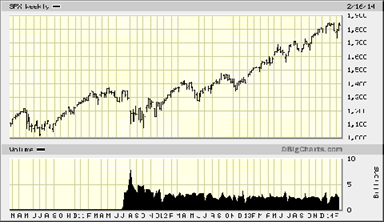The insightful investor understands mean reversion. It is a mystery concept for most – fancy talk.
I will attempt a commonsense explanation with some relevant examples. In conclusion, I will show why this is important.
The Technical Definition
Wolfram MathWorld is a great source on issues like this:
Reversion to the mean, also called regression to the mean, is the statistical phenomenon stating that the greater the deviation of a random variate from its mean, the greater the probability that the next measured variate will deviate less far. In other words, an extreme event is likely to be followed by a less extreme event.
Please note the specific condition of a "random variate."
The Use in Finance
In the financial world, it is commonplace to enhance your arguments about investments with technical jargon. Many readers or viewers get lost along the way. Let me start with a popular application of the concept, the pairs trade.
Suppose that your study of stocks in a specific sector identifies some candidates that you believe to be overvalued and others that are undervalued. This can be an ideal situation for a pairs trade. By going long the cheap stock and selling short the expensive one, you eliminate both the overall effect of the market and also the trends in the specific sector. Your trade focuses on the valuation difference between the selected stocks. You might choose Coke (KO) and Pepsi (PEP) or Ford (F) and GM.
Here is an illustration using the SPDR Gold Trust ETF, (GLD) (the gold SPDR, representing the actual metal) and Market Vectors Gold Miners, (GDX) (the ETF of gold miners).
Notice how deviations in the series closed up during the period from 2009 through 2011. Since then, the trade has not worked very well. If you have been implementing it since the start of 2012 it has been expensive. You might have doubled down, tripled down, or stopped out your position and re-entered. You might have decided to question your original assumption about the relationship between the two. Sometimes the miners hedge their positions by selling gold futures, for example.
The one thing you would not do – at least if you wanted to stay in business – would be to stubbornly stick to the same story without even questioning your thesis.
To summarize, a pairs trade can work in one of three ways:
- The overvalued stock can decline
- The undervalued stock can appreciate
- Some combination of the two
By holding both ends of the trade, you mitigate some risks, although you might still be wrong on the thesis.
And now – the Mystery application
If you follow investment commentary at all, you have seen the most common argument about mean reversion: profit margins. A wide range of pundits insists on the following points:
- Profit margins have a powerful mean-reverting tendency
- Margins are at unsustainably high levels
- Stocks are wildly over-valued as a result. Expect a 30-40% haircut.
This analysis is actually a concealed pairs trade, as is any such argument that involves a ratio. The subject of the mean reversion argument combines two elements: Profits and revenue. Assuming that you agree on the main theme --margins have expanded beyond the normal relationship, the discrepancy could be resolved in any of the classic three ways:
- Profits could decline while revenues remain constant
- Revenues could increase while profits remain constant
- Some combination of the two
The Pundit Error
If a hedge fund employee spotted a potential pairs discrepancy and took only one side of the trade, what do you think would happen?
It would be treated as a rookie mistake – a blunder. He would be admonished or fired if beyond his trading discretion.
Meanwhile, pundits insistently, year-after-year insist that the profit margin issue will be resolved by declining profits. They are betting the ranch on one side of the trade, and picking the wrong one at that. They do not seem to understand that margins are high because revenues are pressured and companies got lean and mean. As the economy and revenues improve, then there will be more competition and profit margins will become more normal.
Please note: This does not require an absolute reduction in earnings and certainly not the doomsday stock forecast. It will be a normal process of economic growth.
Three Ways to Check
This error has been so expensive for investors it may be difficult for them to take an objective, fresh look. Shouldn't we expect more from the pundits? Suppose you stated this profit margin thesis emphatically several years ago, and the results suggest you are wrong. When does the evidence get strong enough for you to reexamine the thesis?
-
About three years ago I did a favorable review of Vitaliy N. Katsenelson's The Little Book of Sideways Markets. I cited the strong support he had from leading voices like Doug Kass and John Mauldin. I also completely disagreed with the thesis and explained why.
Regular readers know that I completely disagree with this thesis. My analysis of data shows that when market participants have an obsessive concern about a recession, the P/E multiples reflect this. There is plenty of evidence that most people think we are still in a recession, so there is intense skepticism about earnings growth. Even a modest level of economic growth will restore some confidence. I already see this in many indicators that I follow each week. I predict an expansion in the P/E multiple, and each point is about 7-8% of growth.
My conclusion is that the economy can grow modestly, earnings growth can slow, and yet ---- some confidence can be restored, increasing the multiple. Unlike other contestants in this discussion, I actually have some data on my side. Time will tell who is correct.
This raises a good question. If I disagree with the major thesis, why do I like the book?
It is pretty easy to see who was right. Profit margins are higher than ever and here is the market chart:
If the profit margin argument sent you to the sidelines, you lost big time.
- Assuming everything as equal. Every writer has a few posts that they feel did not get enough attention. Maybe my marketing department should have told me to call this something like "the 1929 chart" instead of Ceteris Paribus. How could I have guessed? Please check it out for an explanation of why the profit margin argument is bogus, my feelings about Jack Reacher, and why you get fooled by bogus charts.
- What is left out of daily commentary? Do not allow others to set the agenda! By focusing the market debate on some obscure relationship, investors lose track of actual progress. Take a step back and clear your mind. There has been progress – a lot of it. Better earnings, lower recession odds, less Washington worry, less debt, and reduced headwinds. Don't believe it? Check here, where the Dow was at 10k and many were calling for it to go to 5K.
A Final Thought
I sometimes get stupid comments from trolls or hate-types suggesting that I am hyping stocks. Readers should learn how to differentiate among sources. Fee-based investment advisors profit only when their clients do well. Unlike the "bond kings" we do not have a pre-set agenda. I have programs that emphasize bonds, conservative stocks with covered calls, trading, actively managed long themes, and aggressive investments. My interests are aligned with clients and readers. My market viewpoint changes with the evidence. Those who want to follow the themes get free advice. Those who think I can add value become clients.
I actually have the best program for a sideways market, a concept that will be familiar to regular readers.
I constantly search for the best sources on each theme. You get my unvarnished opinions, and comments are always welcome!


